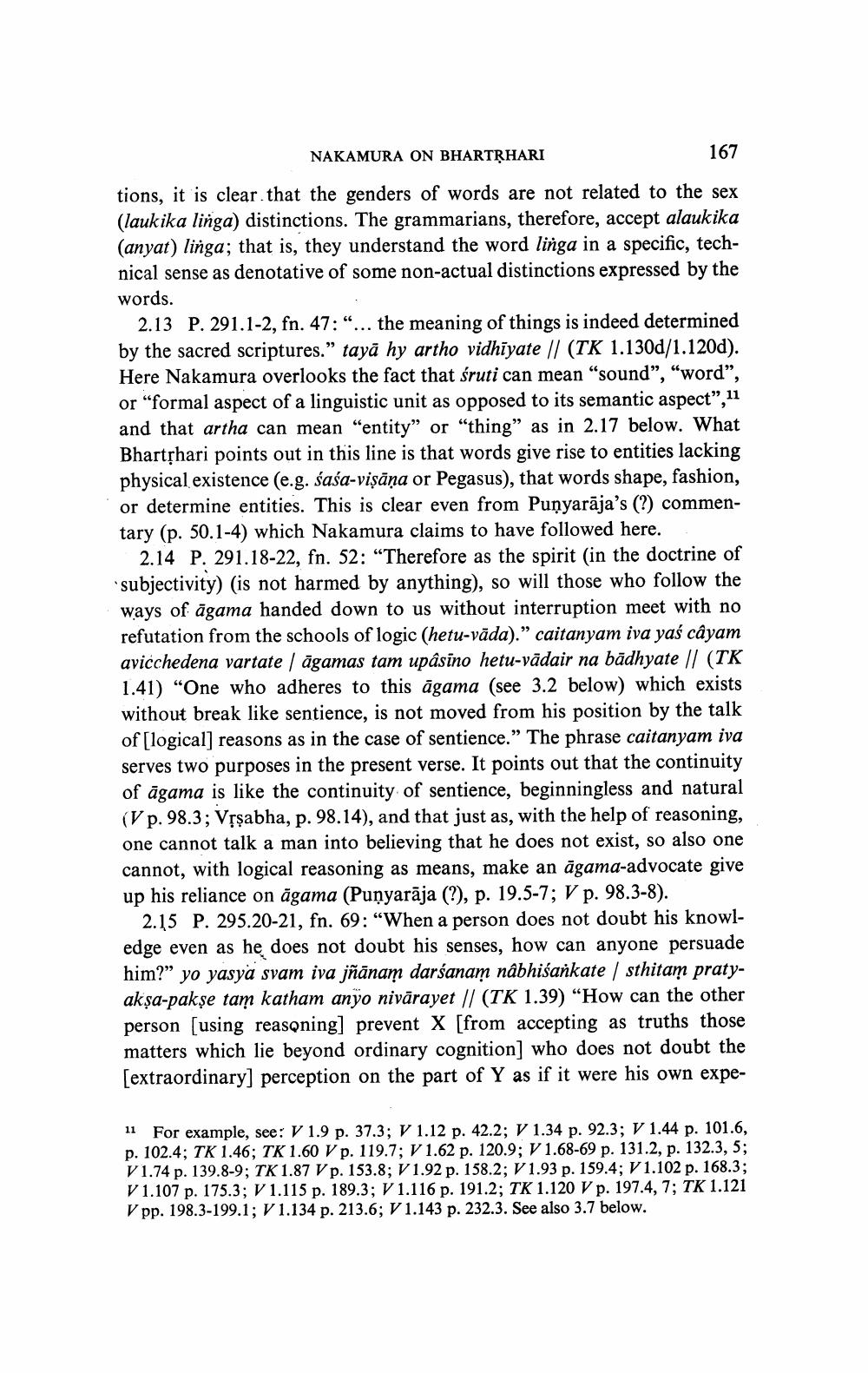Book Title: Nakamura On Bhartrhari Author(s): Ashok Aklujkar Publisher: Ashok Aklujkar View full book textPage 7
________________ NAKAMURA ON BHARTķHARI 167 tions, it is clear that the genders of words are not related to the sex (laukika linga) distinctions. The grammarians, therefore, accept alaukika (anyat) linga; that is, they understand the word linga in a specific, technical sense as denotative of some non-actual distinctions expressed by the words. 2.13 P. 291.1-2, fn. 47: "... the meaning of things is indeed determined by the sacred scriptures.” tayā hy artho vidhīyate // (TK 1.130d/1.120d). Here Nakamura overlooks the fact that śruti can mean “sound”, “word”, or "formal aspect of a linguistic unit as opposed to its semantic aspect”, 11 and that artha can mean "entity" or "thing” as in 2.17 below. What Bhartshari points out in this line is that words give rise to entities lacking physical existence (e.g. sasa-vişāņa or Pegasus), that words shape, fashion, or determine entities. This is clear even from Punyarāja's (?) commentary (p. 50.1-4) which Nakamura claims to have followed here. 2.14 P. 291.18-22, fn. 52: “Therefore as the spirit (in the doctrine of subjectivity) is not harmed by anything), so will those who follow the ways of agama handed down to us without interruption meet with no refutation from the schools of logic (hetu-vāda)." caitanyam iva yaś câyam avicchedena vartate / āgamas tam upâsino hetu-vādair na bādhyate || (TK 1.41) "One who adheres to this agama (see 3.2 below) which exists without break like sentience, is not moved from his position by the talk of [logical] reasons as in the case of sentience.” The phrase caitanyam iva serves two purposes in the present verse. It points out that the continuity of agama is like the continuity of sentience, beginningless and natural (V p. 98.3; Vșşabha, p. 98.14), and that just as, with the help of reasoning, one cannot talk a man into believing that he does not exist, so also one cannot, with logical reasoning as means, make an agama-advocate give up his reliance on agama (Punyarāja (?), p. 19.5-7; V p. 98.3-8). 2.15 P. 295.20-21, fn. 69: “When a person does not doubt his knowledge even as he does not doubt his senses, how can anyone persuade him?” yo yasya svam iva jñānam darśanam nâbhisankate / sthitam pratyakşa-pakşe tam katham anyo nivārayet || (TK 1.39) “How can the other person (using reasoning] prevent X [from accepting as truths those matters which lie beyond ordinary cognition] who does not doubt the [extraordinary] perception on the part of Y as if it were his own expe 11 For example, see: V 1.9 p. 37.3; V 1.12 p. 42.2; V 1.34 p. 92.3; V 1.44 p. 101.6, p. 102.4; TK 1.46; TK 1.60 V p. 119.7; V 1.62 p. 120.9; V 1.68-69 p. 131.2, p. 132.3, 5; V 1.74 p. 139.8-9; TK 1.87 V p. 153.8; V 1.92 p. 158.2; V 1.93 p. 159.4; V 1.102 p. 168.3; V 1.107 p. 175.3; V 1.115 p. 189.3; V 1.116 p. 191.2; TK 1.120 V p. 197.4, 7; TK 1.121 V pp. 198.3-199.1; V 1.134 p. 213.6; V 1.143 p. 232.3. See also 3.7 below.Page Navigation
1 ... 5 6 7 8 9 10 11 12 13 14 15
